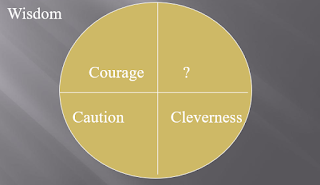This post is the fourth in a series on vocabulary instruction. Part 1 provided an overview, Part 2 focused on the conceptual base for vocabulary, and Part 3 described the List-Group-Label-Add Strategy.
When a mature reader encounters an unfamiliar word while reading, the first move is likely to be to try to determine the meaning of the word from the context. Because they are trying to communicate with the reader, author's typically leave clues to the meanings of the words they are using in the text (not intentionally, but as a natural part of the communication process). Perhaps because this strategy seems so natural to us as readers, we sometimes assume that students will use the strategy effectively, too. So when a child encounters a word she doesn't know in a text, our advice is often, "Skip it, read on, and see if you can figure it out from the context."
This is good advice, but not good instruction. As maturing, not yet mature readers, students need help in efficiently using the skip-and-read-on strategy. Authors leave clues in a variety of ways in texts. Knowledge about what kinds of clues authors leave and how to identify those clues can help students determine the meaning of unknown words in context. This is a critical skill, since it allows the reader to continue on in the reading without interruptions to look up words, so comprehension is enhanced. It is also critical because it means that readers are building their vocabulary through the act of reading.
The chart below shows six ways that authors leave clues in text. Readers need to be able to identify these clues in their reading. The chart is arranged from the most concrete (definition) to the most abstract (mood or tone) clues.
Instruction in the use of these strategies follows the same gradual release of responsibility model that I have discussed in previous posts. Here is how I would use this model for context clues. What the teacher might say to the students is in italics.
- Introduce the strategy to the students and tell them why it is important and useful for them as readers. As we have discussed, good readers use the context of what they are reading to help them figure out the meaning of new words. This is important because it allows us to continue reading without interruption and because it helps us build our store of words while we are reading. Today we will continue our study of vocabulary in context, by looking at one type of clue that authors provide for us while reading: contrast
- Model the strategy through a read aloud/think aloud demonstration. Let's say that we come across this sentence in our reading: "Unlike her older brother Jerome, who stayed out all hours of the night, Kate obediently followed the curfew her parents set." In this sentence I am unsure of the meaning of the word obediently, to try and figure out the meaning I read the full sentence again including the words that come after the word I do not know. In this sentence, the context tells me that Kate is unlike her brother. I also know that Kate's brother stayed out all night and broke the curfew. So if Kate is not like her brother, is a contrast to her brother, she must be a person who follows the rules. So obediently must mean something like following the rules. Let me reread the sentence and see if that makes sense. If it does make sense I can read on. This modeling can take place over several examples.
- Work collaboratively with students in using the strategy. Now that I have shown you several examples, let's look at this next sentence and see if we can work together to figure out its meaning using the contrast clue...
- Give the students opportunities for guided practice of the strategy with partners or in small groups, while you monitor their use of the strategy. Let's now get into groups of three and I want you to work together on the next three sentences to use the contrast clues in these sentences to determine the meaning of the word...While the students work, the teacher moves around listening in, redirecting and coaching use of the strategy.
- Give students the opportunity to practice the strategy independently. Now it is time for independent reading. As you read today, see if you encounter any words that you do not know and see if the author has left a contrast clue to help you determine the meaning of the word. Checking in with students as they read, the teacher can monitor the use of context clue strategies.
This process can be used for each of the types of clues and eventually, the students can practice identifying the clues that they used and the meanings of the words they encounter in the text. Pearson and Gallagher, who developed the gradual release model, warn that teachers should not rush through the collaborative and guided stages of this lesson - this coaching art of the lesson has been shown to be critical for student success.
The use of context clues to determine word meaning is a critical skill in reading that not all students adopt automatically. The strategy can be taught, however, and arming students with the knowledge that clues to meaning are available and helping them identify what those clues are, not only aids reading comprehension, but also helps students build their vocabulary while they are reading independently.











